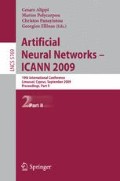Abstract
At the ground of most brain computations may be minimal abstract selectional machines (ASMs) implementing optimal algorithms of recent binary signal detection theory (BSDT). Using the BSDT ASMs, such fundamental cognitive notions as subjectivity and the meaning of a message have already been defined mathematically. BSDT neural network assembly memory model provides strict and biologically plausible definition of optimal assembly memory units (AMUs, implementations of ASMs) which may be considered as ‘atoms’ of consciousness (AOCs). The idea of an AOC is here developed into an ‘atom’ of consciousness model (AOCM) — a mathematical theory of consciousness. Neuronal computational structures leading to the emergence of subjective experience or a ‘quale’ (a formal solution of the ‘hard problem’ of consciousness) are presented as complex dynamical hierarchical associations of AMUs/AOCs of infinite prehistory. Within the AOCM framework some cognitive phenomena are explained and it has been demonstrated that unified and modular biological models of consciousness are not antithetical.
Access this chapter
Tax calculation will be finalised at checkout
Purchases are for personal use only
Preview
Unable to display preview. Download preview PDF.
References
Edelman, G.M.: Naturalizing Consciousness: A Theoretical Framework. Proc. Natl. Acad. Sci. 100, 5520–5524 (2003)
Crick, F., Koch, C.: A Framework for Consciousness. Nature Neurosci. 6, 119–126 (2003)
Chalmers, D.: The Conscious Mind. Oxford Uni. Press, Oxford (1996)
Gopych, P.M.: Elements of the Binary Signal Detection Theory, BSDT. In: Yoshida, M., Sato, H. (eds.) New Research in Neural Networks, pp. 55–63. Nova Science, New York (2008)
Gopych, P.M.: Foundations of the Neural Network Assembly Memory Model. In: Shannon, S. (ed.) Leading Edge Computer Sciences, pp. 21-84. Nova Science, New York (2006)
Gopych, P.: Minimal BSDT abstract selectional machines and their selectional and computational performance. In: Yin, H., Tino, P., Corchado, E., Byrne, W., Yao, X. (eds.) IDEAL 2007. LNCS, vol. 4881, pp. 198–208. Springer, Heidelberg (2007)
Gopych, P.: Biologically Plausible BSDT Recognition of Complex Images: The Case of Human Faces. Int. J. Neural Systems 18, 527–545 (2008)
Gopych, P.: BSDT Multi-valued Coding in Discrete Spaces. In: Corchado, E., Zunino, R., Gastaldo, P., Herrero, Á. (eds.) CISIS 2008. ASC 53, pp. 258–265. Springer, Heidelberg (2009)
Li, M., Vitányi, P.: An Introduction to Kolmogorov Complexity and its Applications, 2nd edn. Springer, Heidelberg (1997)
Davies, P.C.W.: Emergent Biological Principles and the Computational Properties of the Universe. Complexity 10, 11–15 (2004)
Woes, C.: The Universal Ancestor. Proc. Natl. Acad. Sci., USA 95, 6854–6859 (2003)
Bar, M., Kassam, K.S., Ghuman, A.S., et al.: Top-Down Facilitation of Visual Recognition. Proc. Natl. Acad. Sci., USA 103, 449–454 (2006)
Nagel, E., Newman, J.R.: Gödel’s Proof, rev. edn. New York Uni. Press, New York (2001)
Clark, A.: Supersizing the Mind. Oxford Uni. Press, Oxford (2008)
Ullman, S.: Object Recognition and Segmentation by a Fragment-based Hierarchy. Trends Cogn. Sci. 11, 58–64 (2007)
Glassman, R.B.: Topology and Graph Theory Applied to Cortical Anatomy May Help Explain Working Memory Capacity for Four or Three Simultaneous Items. Brain Res. Bull. 60, 25–42 (2003)
Bachmann, T.: Microgenetic Approach to the Cognitive Mind. John Bendjamins Publ., Amsterdam (2000)
Pashler, H.: Dual-Task Interference in Simple Tasks: Data and Theory. Psych. Bull. 116, 220–244 (1994)
Lamme, V., Roelfsema, P.: The Distinct Models of Vision Offered by Feedforward and Recurrent Processing. Trends Neurosci. 23, 571–579 (2000)
Block, N.: Two Neural Correlates of Consciousness. Trends Cogn. Sci. 9, 46–52 (2005)
Tononi, G., Edelman, G.M.: Consciousness and Complexity. Science 282, 1846–1851 (1998)
Zeki, S.: The Disunity of Consciousness. Trends Cogn. Sci. 7, 214–218 (2003)
Cooney, J.W., Gazzaniga, M.S.: Neurological Disorders and the Structure of Human Consciousness. Trends Cogn. Sci. 7, 161–165 (2003)
Author information
Authors and Affiliations
Editor information
Editors and Affiliations
Rights and permissions
Copyright information
© 2009 Springer-Verlag Berlin Heidelberg
About this paper
Cite this paper
Gopych, P. (2009). BSDT Atom of Consciousness Model, AOCM: The Unity and Modularity of Consciousness. In: Alippi, C., Polycarpou, M., Panayiotou, C., Ellinas, G. (eds) Artificial Neural Networks – ICANN 2009. ICANN 2009. Lecture Notes in Computer Science, vol 5769. Springer, Berlin, Heidelberg. https://doi.org/10.1007/978-3-642-04277-5_6
Download citation
DOI: https://doi.org/10.1007/978-3-642-04277-5_6
Publisher Name: Springer, Berlin, Heidelberg
Print ISBN: 978-3-642-04276-8
Online ISBN: 978-3-642-04277-5
eBook Packages: Computer ScienceComputer Science (R0)

